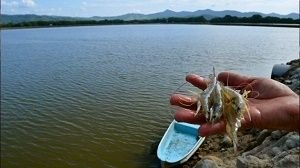
The flourishing shrimp farming industry has revolutionized coastal economies around the world. However, Its long-term sustainability faces challenges; while threats such as diseases and environmental impact are well-known, a lesser-known actor lurks in the background: viruses.
A study published by researchers from the University of Sonora (Mexico), the Northwest Biological Research Center (CIBNOR), Bigelow Laboratory for Ocean Sciences (USA), and the Autonomous University of the State of Morelos (Mexico) in the journal Regional Studies in Marine Science delves into the invisible realm of viruses within shrimp aquaculture facilities.
The study aimed to examine the possible association between biotic and abiotic factors and the abundance and seasonal succession of marine viral communities in surface waters at a shrimp farm in the Gulf of California.
Viruses: The Most Abundant Life Form in the Ocean
Believe it or not, viruses are the most abundant biological entity on Earth, outnumbering the stars in the observable universe! They play a crucial role in marine ecosystems, regulating bacterial populations and influencing biogeochemical cycles. In fact, viruses can kill up to 40% of marine microbes daily.
Viral Abundance in Shrimp Farms: A Developing Mystery
While we know that viruses are abundant in the oceans, their presence in shrimp farms remains a mystery. Early estimates suggested far fewer viruses than actually exist. Recent studies using advanced techniques reveal a much higher viral concentration, with millions of viral particles per milliliter of water in shrimp farm ponds. This abundance suggests frequent encounters between viruses and their hosts, which could impact the health of the entire ecosystem.
Seasonal Changes and Hidden Connections
Like other organisms, viruses respond to seasonal changes. Water temperature, dissolved oxygen, and other factors influence viral diversity and abundance. Interestingly, research suggests a link between viral populations and their bacterial hosts. Viruses may act as a natural control mechanism, preventing any single bacterial species from dominating the ecosystem.
A Deeper Analysis: Revealing the Shrimp Farm’s Viral Community
Recent studies are shedding light on the unique viral communities residing in shrimp farms. These communities are diverse and distinct from those found in natural environments. By analyzing the viral “fingerprint” at different locations within a farm (ponds, breakwaters, and discharge channels), scientists are tracking the movement of viral populations and their potential hosts. Additionally, researchers are using metagenomics to identify the possible hosts of these viruses within the shrimp themselves and the surrounding environment.
Viral Threats and the Need for Knowledge
Crowding and overfeeding in shrimp farms can trigger the emergence of harmful viral pathogens. The limited understanding of the factors influencing viral abundance and diversity further complicates the issue. While some viruses pose a significant threat, others play a crucial role in maintaining healthy ecosystems by controlling bacterial and protozoan populations.
Unveiling the Viral Community
Scientists have traditionally focused on specific viruses that cause diseases in aquaculture. However, the study from Bahía de Kino, Mexico, sheds light on the entire viral community within a shrimp farming facility. By estimating the abundance of virus-like particles, researchers gained valuable insights that could pave the way for better disease management strategies.
Benefits of Understanding the Viral Landscape
By uncovering the factors influencing viral abundance and diversity in shrimp aquaculture, several benefits can be achieved:
- Better Disease Management: Understanding the dynamics of the viral community can help predict and prevent outbreaks of harmful pathogens.
- Promotion of Beneficial Viruses: Identifying viruses that control harmful bacteria and protozoa could lead to strategies that encourage their presence within aquaculture systems.
- Sustainable Practices: A deeper understanding of the viral ecosystem can guide the development of sustainable shrimp farming practices that minimize disease risks and environmental impact.
The Path Ahead
This study represents a significant step forward in understanding the complex world of viruses within shrimp aquaculture. More research is needed to:
- Identify Specific Viruses: Identifying the specific types of viruses present and their ecological functions is crucial.
- Develop Management Strategies: Based on the viral landscape, researchers can develop targeted strategies to control harmful pathogens and promote beneficial ones.
By unveiling the secrets of the viral community, we can move towards a future of sustainable shrimp farming that prioritizes both economic success and environmental well-being.
The Future of Shrimp Farming: Coexisting with the Viral World
Viruses are an undeniable force in shrimp farms, but by understanding their role and dynamics, we can learn to coexist. Harnessing the power of science, we can create a more sustainable and secure future for this vital industry.
Contact
Arturo Sánchez-Paz
Centro de Investigaciones Biológicas del Noroeste S. C. Laboratorio de Virología.
Hermosa 101, Col. Los Ángeles.
Hermosillo, Sonora. México. C. P. 83106.
Email: asanchez04@cibnor.mx
Reference (open access)
Encinas-García, T., Mendoza-Cano, F., De la Re-Vega, E., Martínez, J. M., Dávila-Ramos, S., Grijalva-Chon, J. M., & Sánchez-Paz, A. (2024). Dissecting the main factors affecting the viral abundance in a shrimp aquaculture ecosystem. Regional Studies in Marine Science, 103796. https://doi.org/10.1016/j.rsma.2024.103796
Editor at the digital magazine AquaHoy. He holds a degree in Aquaculture Biology from the National University of Santa (UNS) and a Master’s degree in Science and Innovation Management from the Polytechnic University of Valencia, with postgraduate diplomas in Business Innovation and Innovation Management. He possesses extensive experience in the aquaculture and fisheries sector, having led the Fisheries Innovation Unit of the National Program for Innovation in Fisheries and Aquaculture (PNIPA). He has served as a senior consultant in technology watch, an innovation project formulator and advisor, and a lecturer at UNS. He is a member of the Peruvian College of Biologists and was recognized by the World Aquaculture Society (WAS) in 2016 for his contribution to aquaculture.
